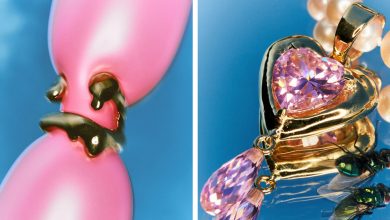A Modernist Gem in Paris, Meticulously Restored

ÉRIC TOUCHALEAUME WAS a teenager in the late 1960s when his cultured, peripatetic parents moved the family from Bordeaux to the Auteuil section of Paris’s posh 16th Arrondissement. Now in his 60s, the prominent dealer of mid-20th-century French design spent those early days exploring his new neighborhood on the edge of the Bois de Boulogne, winding past recherché centuries-old homes with bisque stone facades and quiet courtyards.
One afternoon when he was 15, he came upon a short private street that would shape his future: Rue Mallet-Stevens, a row of five giant, decaying 1920s Modernist townhouses. Touchaleaume was struck by one particular house, No. 10, Hôtel Martel: The names of its original owners were still carved in glass on the door. An arrangement of concrete cubes with a three-story turret topped by an umbrella-like roof with a red glazed tile underside, the structure also had faded yellow blinds that lent a Piet Mondrian effect. Despite its dilapidation, the grand mansion moved him deeply.
But it wasn’t until the late 1980s, more than a decade after becoming an art and antiques dealer who specialized in the early French Modernist period — designers like Charlotte Perriand, Le Corbusier and Jean Prouvé — that Touchaleaume finally set foot in the monolithic house he had never forgotten. He was there to purchase four figurative sculptures from the ground-floor former workshop of the Jazz Age sculptors Jan and Joël Martel, twin brothers whose public statuary can be found throughout France, including the 1932 Claude Debussy fountain on the nearby Boulevard Lannes. The brothers had commissioned the 5,000-square-foot maison, with three residential apartments (one for each of them and another for their father) and an atelier, in 1926; like all the structures on the block, it was the creation of the French architect Robert Mallet-Stevens, a largely forgotten early Modernist master. A contemporary of Le Corbusier and Ludwig Mies van der Rohe’s, he intended the series of buildings as a template for Une Cité Moderne, a breakaway from the staid proportions and ornamentation promulgated in the 19th century by Baron Haussmann, who had remade the boulevards and aesthetics of Paris.
Had he not requested that his archive and sketches be destroyed after his death, in 1945 at age 58 (he and his wife, Andrée, who was Jewish, spent most of the war in southwest France), Mallet-Stevens, who also designed movie sets, furniture and retail spaces, might today be as renowned as Le Corbusier. The scion of an aristocratic French-Belgian family, the architect, who had grown up in the wealthy Parisian suburb of Maisons-Laffitte, created some of France’s seminal ultraminimalist 20th-century country estates between the wars, including the austere 1920s mansion of the Surrealist patrons Charles and Marie-Laure de Noailles in the Riviera town of Hyères, and the fashion designer Paul Poiret’s 25-room villa in Mézy-sur-Seine, an hour west of the capital, which was started in 1922 but left unfinished when Poiret’s company went bankrupt. (It was completed after the war for a new owner by the architect Paul Boyer.) Mallet-Stevens’s designs, which used reinforced concrete, then a relatively new material in Parisian architecture — Henry van de Velde and Auguste Perret’s 1913 Théâtre des Champs-Élysées was one notable predecessor — were scalpel-precise and shorn of ornament, yet decidedly more welcoming and luxurious than those of his Bauhaus contemporaries’. While Le Corbusier was interested in reimagining practical dwellings for the masses (some of his most important projects were public housing developments), Mallet-Stevens was a pure aesthete. Though he built one public commission, a fire station in the 16th Arrondissement, he worked mostly for rich avant-garde clients, marrying the discipline and pure geometry of the 1920s-era Dutch-based de Stijl to the lushness of Art Deco.

Storage units for the Air France building in Brazzaville, Republic of Congo, by Charlotte Perriand and Jean Prouvé, 1952; a chair reupholstered in teal leather by Jeanneret, circa 1955; canework chairs by Jeanneret, circa 1955; a table by Touret, Atelier Marolles, 1961; and ceramics by Antonio Sabatelli, Alice Colonieu and Edouard Cazaux.Credit…Matthew Avignone
Best known for challenging the orthodoxy of the traditional countryside chateau, he was by nature an urbanist. Financed by the Parisian banker Daniel Dreyfus, for whom he built No. 7, the Rue Mallet-Stevens, which was inaugurated in July 1927, became home to a group of bohemians who were fans of Modern architecture, including Éric Allatini, a writer and choreographer, and his wife, Hélène Allatini, who ran a literary salon at their house (Nos. 3-5). (During World War II, the couple were arrested by the French Gestapo, who requisitioned their house and sent them to Drancy, outside Paris; they died at Auschwitz after being transferred there in 1943.) Mallet-Stevens lived and worked in the corner house, No. 12. The original vision called for another lot to be built, but those plans were foiled by the 1929 collapse of the stock market.
DECADES LATER, IN 2007, Touchaleaume saw a listing in the paper for Jan Martel’s former duplex at No. 10, and quickly purchased the apartment, which is accessed from the central spiral staircase. (There is a longtime tenant in Joël’s duplex.) No. 10 is the only house on the block that remains entirely intact, with its original hardware and fittings, having escaped the unfortunate renovations and additions that befell the others. Eight years later, Touchaleaume also purchased the 1,900-square-foot adjoining L-shaped atelier, relocating into it his art and antiques showroom, Galerie 54.
This was not the dealer’s first outsize gesture. Known for his resourcefulness and doggedness, he’d years earlier traveled to Niamey, Niger, and Brazzaville, Republic of Congo, to bring back three Maisons Tropicales, prototypes for flat-pack prefabricated housing made of folded steel and aluminum panels that Prouvé had designed in 1949 for the French colonies. Touchaleaume restored the ramshackle structures and later sold one in a Christie’s auction to the hotelier André Balazs for nearly $5 million. (It was exhibited in front of London’s Tate Modern in 2008.)
So the gallerist was undaunted by the prospect of restoring the Hôtel Martel to its original condition, as well as unfazed by the level of disrepair, the need for constant upkeep and even the inconvenience of living and working in a highly conceptual space. “I’ve always loved the poetry of derelict buildings” from the between-the-wars period, he says, “that utopia of Modernism.”
Mallet-Stevens famously designed from the inside out, researching how the occupants intended to use their dwellings. The architect regarded light as an important design element: At the Hôtel Martel, sun streams through the atelier’s massive south- and east-facing mullioned windows and the 90-degree corner panes of the main bedroom. Mallet-Stevens had engineered central heating, as well as bathrooms with hot and cold running water, still uncommon in Parisian homes at the time. (Touchaleaume kept and restored the original cumbersome porcelain fixtures.) The bedroom floors, made from a mix of powdered cork and cement, were an early experiment in insulation and soundproofing, and the treads of the central staircase were made from terrazzo, a material then confined largely to swimming pools and butcher shops. (Round mirrors on the floor and ceiling multiply the stairs into infinity.) Using chromatic research by the curators of the Centre Pompidou’s 2005 Mallet-Stevens retrospective, Touchaleaume restored the walls to their original colors, from buttery Naples yellow in the living room to chalky shades of blue and gray in the tiny kitchen, which retains its original layout and fixtures, including a clever pullout counter-shelf.
Many of the interior decorations remain as well. The white, silver and red geometric stained-glass stairwell window, which runs almost the full height of the tower that connects the atelier to the living quarters, is by Louis Barillet, whose vast house and studio in the 15th Arrondissement Mallet-Stevens later designed. Édouard-Joseph Bourgeois, who designed several rooms at Villa Noailles under his moniker Djo-Bourgeois, built a space-saving storage module that hugs the contours of the stairwell. So faithful to Mallet-Stevens’s vision is Touchaleaume that he sleeps in the short, narrow double bed that the architect designed for Jan Martel.
Although the apartments above the atelier remain as sparsely furnished as they were when the twin sculptors occupied them, Touchaleaume has added to his 900-square-foot living space a coffee table by Perriand and armchairs by Giulio Minoletti. On the wall of his bedroom hangs his most prized work: an original painting on silk of a lotus and a dragonfly by Yokoyama Taikan, a master of the Nihonga style that emerged in Meiji-era Japan.
The platform at the top of the tower, below the red mosaic ceiling held up by a concrete belvedere, offers a view of the rooftops of the area’s aristocratic 18th- and 19th-century homes; the Martels once held cocktail parties on the roof terrace, attended by many of their fellow artists. When the weather is fair, Touchaleaume sits with a glass of rosé on his own second-floor terrace, exchanging shouted greetings with other Rue Mallet-Stevens residents. There is a camaraderie among them that defies the quiet chicness of the neighborhood — residing on Rue Mallet-Stevens is a bold statement, even today. “I’m living in a slice of history,” Touchaleaume says. “It makes me happy to know it will be protected long after I’m gone.”
Photo assistant: Lilly Merck





